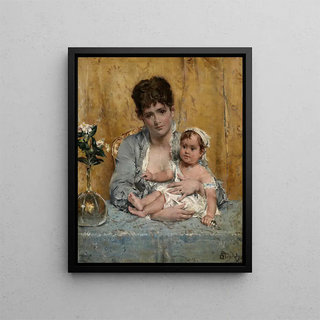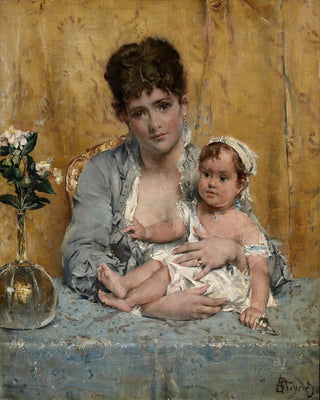Art print | Mother and Child - Alfred Stevens


View from behind

Frame (optional)
In the world of art, some works manage to capture the very essence of human emotions. "Mother and Child" by Alfred Stevens is a perfect example. This canvas, imbued with tenderness and delicacy, evokes the beauty of the maternal bond through an intimate and poetic gaze. Immersing oneself in this piece, the viewer is transported to a universe where time seems suspended, where each brushstroke tells a story of unconditional love. The scene depicts a mother caressing her child, a simple gesture but one filled with profound meanings. This representation of motherhood, both universal and intimate, invites reflection on the role of women in society, while celebrating childhood's gentle innocence.
Style and uniqueness of the work
Alfred Stevens' style is distinguished by its striking realism and his ability to capture the nuances of human emotions. In "Mother and Child," meticulous details and a palette of soft colors enhance the warm atmosphere of the scene. The faces of the protagonists, imbued with touching serenity, are illuminated by a gentle light that accentuates their natural beauty. Stevens manages to create an intimate ambiance, where every element, from the draping of clothing to the expressions of the characters, contributes to the harmony of the whole. The composition, carefully orchestrated, guides the viewer's gaze toward the palpable bond between the mother and her child, thus revealing the depth of their relationship. This piece is not merely a simple representation; it becomes a celebration of life and love.
The artist and his influence
Alfred Stevens, an emblematic figure of the 19th century, knew how to mark his era with his innovative approach to painting. Originating from Brussels, he established himself on the Parisian art scene, where he mingled with masters such as Gustave Courbet and Édouard Manet. His style, influenced by emerging realism and impressionism, allowed him to explore various themes, ranging from genre scenes to more intimate portraits. Stevens captured the subtleties of daily life while highlighting the beauty of human relationships. His work had a significant influence on

Matte finish

View from behind

Frame (optional)
In the world of art, some works manage to capture the very essence of human emotions. "Mother and Child" by Alfred Stevens is a perfect example. This canvas, imbued with tenderness and delicacy, evokes the beauty of the maternal bond through an intimate and poetic gaze. Immersing oneself in this piece, the viewer is transported to a universe where time seems suspended, where each brushstroke tells a story of unconditional love. The scene depicts a mother caressing her child, a simple gesture but one filled with profound meanings. This representation of motherhood, both universal and intimate, invites reflection on the role of women in society, while celebrating childhood's gentle innocence.
Style and uniqueness of the work
Alfred Stevens' style is distinguished by its striking realism and his ability to capture the nuances of human emotions. In "Mother and Child," meticulous details and a palette of soft colors enhance the warm atmosphere of the scene. The faces of the protagonists, imbued with touching serenity, are illuminated by a gentle light that accentuates their natural beauty. Stevens manages to create an intimate ambiance, where every element, from the draping of clothing to the expressions of the characters, contributes to the harmony of the whole. The composition, carefully orchestrated, guides the viewer's gaze toward the palpable bond between the mother and her child, thus revealing the depth of their relationship. This piece is not merely a simple representation; it becomes a celebration of life and love.
The artist and his influence
Alfred Stevens, an emblematic figure of the 19th century, knew how to mark his era with his innovative approach to painting. Originating from Brussels, he established himself on the Parisian art scene, where he mingled with masters such as Gustave Courbet and Édouard Manet. His style, influenced by emerging realism and impressionism, allowed him to explore various themes, ranging from genre scenes to more intimate portraits. Stevens captured the subtleties of daily life while highlighting the beauty of human relationships. His work had a significant influence on






